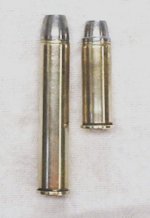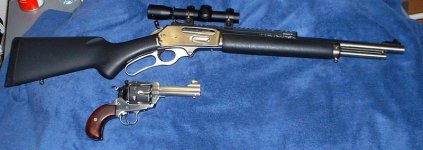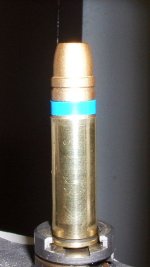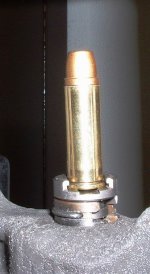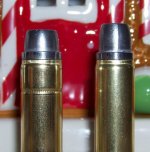SC; On the Lee crimp. G4F has it right, this type of crimp if applied correctly will stop set back and jump. It will also aid in ballistic uniformity/accuracy. Just about everybody I know who are serious lead shooters, accuracy buffs, and (like G4F mentioned) those that hunt large dangerous game with rifle and handgun, use this type of crimp.
The crimping groove on most cast bullets is about .050 to .060 or so. On most cast bullets, the top part of the groove is a flat/square edge that sits under the nose. The bottom part of the groove is a bevel.
The key to getting the proper heavy crimp is to allow the swage of the crimp at the mouth of the case to sit against the flat/square edge of the crimp groove beneath the nose of the bullet, and then to apply enough pressure to the crimp to allow the lower portion of the crimp to pinch the bevel on the lower side of the crimp groove. You will know when you are there by the pressure that is exerted by your press, and when you see a near vertical swage on the case mouth. (see my previous photos).
What you will end up with is a swaged crimp that is as wide as the crimp groove on the bullet. This is the ideal crimp for this type of die............also, I have used these dies for years, and have cases that I have used for years and many loadings.....well over 20 with one set of 100 cases that I use for 44 Mag testing purposes. I have never had a case mouth crack or any case issues, and, I have never annealed the cases.
I believe I read that you are now working with the 45LC in a handgun? If so, set your dies up to size in this manner and then go to your starting load and work up.......I think you will like the benefits of this type of crimp, especially for the top end loads! Use this crimper die as an extra/seperate step. Seat your bullet in your regular seating die, and allow that die to roll the bell of the case mouth back to its vertical position. Then go on to the Lee Die to apply the final swaged crimp. If you are working with compressed powder charges, allow your regular seating die to apply a light crimp to hold the bullet until the Lee die completes the crimping process.
Here is a photo of my 444 Marlin. I built this rifle 2 years ago. I shortened the barrel to 16.5", and lapped it to a perfect .4305 chamber/.4300 muzzle dimension. I shoot cast .432 sized bullets. I also modified this rifle to take an oversized COL. The standard for the 444 in the Marlin is 2.580. After reworking the cycling spaces (which requires parts modifications/TIG welding, etc), retiming the action and giving everything a precise fitting and polishing. The action is now "butter smooth". This rifle will now take a 2.655 COL. That is an increase in 5 grains of powder, uncompressed! This gives me the power of the 404 Jeffrey/400-450 Nitro Express 3" with like weight bullets. I also bedded and freefloated an MPI Kevlar/Graphite stock and finished it off, added a reworked WWG Happy Trigger and WWG Bearproof Ejector, and a Longhunter one piece firing pin. The rear peep, front post, and scope rail is by XS Systems, the rings are Warne Optima Quick Detachables, and the Scope a Leupold 2.5 Ultralight. This gun weighs 6.2 pounds field ready, and is short and very handy in the thick environment that I hunt in...and best of all it is a "one holer"!!!......The revolver in the photo is my New Model Super Blackhawk that I just finished up on. Birds Head Grip, cocobolo grips, 4" barrel...the works. I carry this in a weak side crossdraw holster that was made for me by Alan at Chisholms Trail Leathers. It is the Ranger Flat Top Crossdraw, and for rifle carry it is ideal...keeps the handgun out of the way of the rifle...carries close and tight to the body, and allows for draw with either hand....This gun is also set up for lead, and shoots one hole groups.

